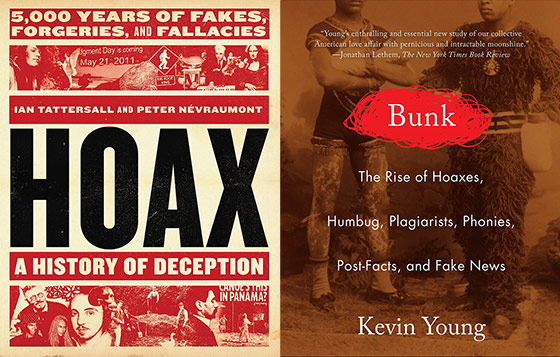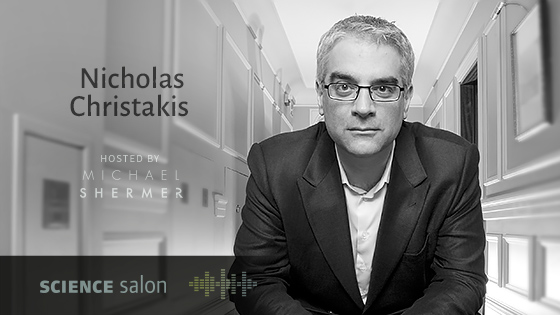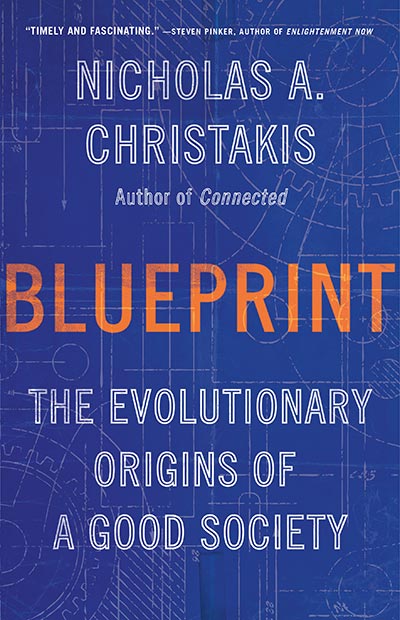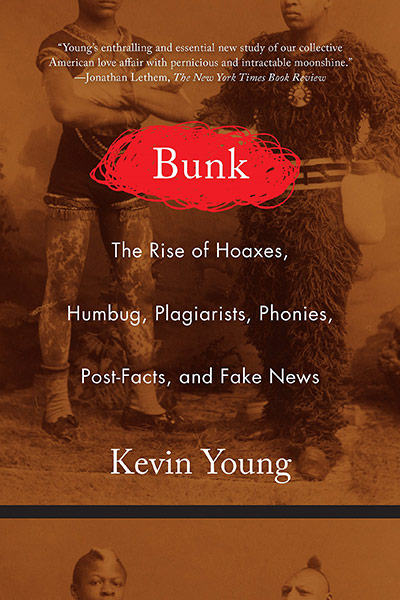SCIENCE SALON # 60
Nicholas A. Christakis — Blueprint: The Evolutionary Origins of a Good Society
In this exceptionally important conversation Dr. Shermer discusses at length the background to and research of Dr. Nicholas Christakis, a physician and evolutionary sociologist famous for his study of social networks in humans and other animals. Drawing on advances in social science, evolutionary biology, genetics, neuroscience, and network science, Blueprint shows how and why evolution has placed us on a humane path—and how we are united by our common humanity. For too long, scientists have focused on the dark side of our biological heritage: our capacity for aggression, cruelty, prejudice, and self-interest. But natural selection has given us a suite of beneficial social features, including our capacity for love, friendship, cooperation, and learning. Beneath all our inventions—our tools, farms, machines, cities, nations—we carry with us innate proclivities to make a good society. In Blueprint, Nicholas A. Christakis introduces the compelling idea that our genes affect not only our bodies and behaviors, but also the ways in which we make societies, ones that are surprisingly similar worldwide. With many vivid examples—including diverse historical and contemporary cultures, communities formed in the wake of shipwrecks, commune dwellers seeking utopia, online groups thrown together by design or involving artificially intelligent bots, and even the tender and complex social arrangements of elephants and dolphins that so resemble our own—Christakis shows that, despite a human history replete with violence, we cannot escape our social blueprint for goodness. Shermer and Christakis also discuss:
- his background and how he got into studying social networks and society
- why evolutionary psychology is an equal opportunity offender (Right: biological creationism; Left: cognitive creationism)
- the 8-character suite of human nature that goes into building a good society
- Unintentional Communities like shipwrecks
- Intentional Communities like communes
- Artificial Communities like Seasteading
- love and why it matters for a good society, and not just a good life
- friends and social networks
- genes and culture co-evolution
- boo words like positivism, reductionism, essentialism, determinism and why we need not fear them
- Hume’s Wall: is-ought naturalistic fallacy
- engineering new social worlds and governing Mars.
Dr. Nicholas A. Christakis is a physician and sociologist who explores the ancient origins and modern implications of human nature. He directs the Human Nature Lab at Yale University, where he is the Sterling Professor of Social and Natural Science, in the Departments of Sociology, Medicine, Ecology and Evolutionary Biology, Statistics and Data Science, and Biomedical Engineering. He is the Co-Director of the Yale Institute for Network Science and the co-author of Connected: The Surprising Power of Our Social Networks and How They Shape Our Lives.
Listen to the podcast via Apple Podcasts, Spotify, Google Podcasts, Stitcher, iHeartRadio, and TuneIn.
This Science Salon was recorded on March 27, 2019.
Check Us Out On YouTube.
Science Salons • Michael Shermer
Skeptic Presents • All Videos
You play a vital part in our commitment to promote science and reason. If you enjoy the Science Salon Podcast, please show your support by making a donation.

The breadth of what can be meant by the word “hoax” makes the concept — and consequences — worthy of renewed study. Michelle E. Ainsworth reviews Bunk: The Rise of Hoaxes, Humbug, Plagiarists, Phonies, Post-Facts, and Fake News by Kevin Young and Hoax: A History of Deception: 5000 Years of Fakes, Forgeries, and Fallacies by Ian Tattersall and Peter Nevraumont. These reviews appeared in Skeptic magazine 24.1 (2019).
Hoaxed!
In 1980, Alan Abel hoaxed the New York Times into prematurely reporting his death. Thus, in September 2018, his obituary in the same newspaper carried the unusual heading “Alan Abel is (really) Dead.” The contrast of that prank to the President of the United States calling climate change a “hoax” exemplifies the breadth of what can be meant by the word, and makes the concept and consequences of hoaxes worthy of renewed study. Two new books examine the history of hoaxes from different intellectual perspectives. In Bunk, poet Kevin Young uses primary sources to analyze the history of hoaxes, with an emphasis on racial issues and recent fabricated writings. In contrast, the much shorter book Hoax, coauthored by an anthropologist and a science writer, uses secondary sources and full-page photographs to introduce hoaxes of all types, times, and places.
Bunk opens by discussing the racism of the early “humbugs” of iconic 19th century U.S. entrepreneur P.T. Barnum, including the slave he claimed was 161 years old, and the African American man Barnum eventually advertised as a missing link in the then new Darwinian evolutionary theory. I found it exciting that Young explicitly linked the popularity of these exhibits to the rise of scientific racism, discussing the work of eminent mid-19th century natural scientist Louis Agassiz and skull measuring anthropologist Samuel G. Morton. (Skeptic readers will appreciate that Young relies on the analysis of late 20th century skeptic Stephen Jay Gould’s Mismeasure of Man, noting that part of the problem was what we would now call confirmation bias. After his death Gould was himself accused of mismeasuring Morton’s data in a widely discussed article, but subsequent analyses vindicated Gould. Too bad he isn’t still around to join in the debate.) Science appears elsewhere in Bunk too: the séance craze piggybacking on science is mentioned, the hysteria theories of Charcot are discussed, and Oliver Sacks work on the fallibility of memory is noted.
Young’s real contribution, though, is in offering a racial interpretation of hoaxes not so obviously about race. Three examples are his analysis of the 1835 claim by the newspaper the New York Sun of life on the moon (falsely citing real astronomer Sir John Herschel), the late 19th century popularity of spiritualist seances, and the 1917 Cottingley fairy photograph hoax by two girls. Young argues that in each of these hoaxes, the fantastic beings inhabited an imaginary world that was tellingly similar to the real one.
The Cottingley fairy discussion includes the memorable line that for people of the time it was a “comfort to know fairies fluttered among them in a world changing at the newly discovered speed of light.” Young’s discussion of the Cottingley fairy hoax also exemplifies the thoroughness of his research, as he notes three points missing from most accounts: fairy proponent Arthur Conan Doyle’s father’s prior fondness for painting fairies, skeptic James Randi’s discovery of the source illustrations used to create the hoax fairies, and the late 20th century confession of one of the hoax’s perpetrators. […]













